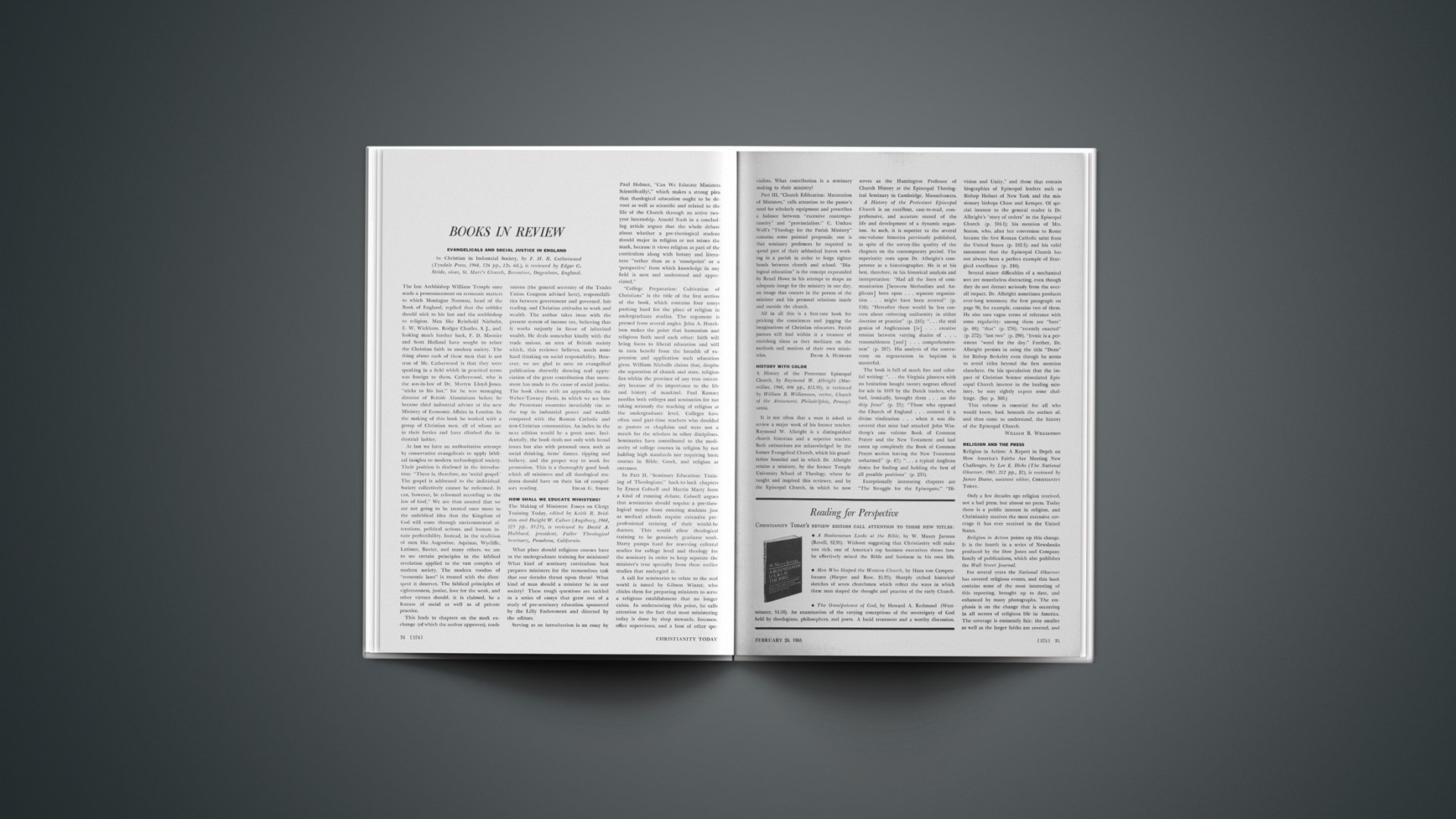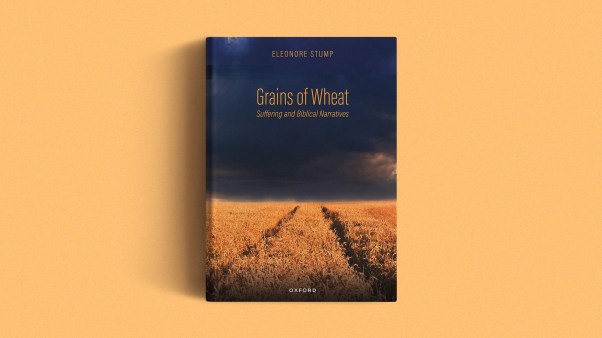Evangelicals and Social Justice in England
The Christian in Industrial Society, by F. H. R. Catherwood (Tyndale Press, 1964, 126 pp., 12s. 6d.), is reviewed by Edgar G. Stride, vicar, St. Mary’s Church, Becontree, Dagenham, England.
The late Archbishop William Temple once made a pronouncement on economic matters to which Montague Norman, head of the Bank of England, replied that the cobbler should stick to his last and the archbishop to religion. Men like Reinhold Niebuhr, E. W. Wickham. Rodger Charles, S. J., and, looking much further back, F. D. Maurice and Scott Holland have sought to relate the Christian faith to modern society. The thing about each of these men that is not true of Mr. Catherwood is that they were speaking in a field which in practical terms was foreign to them. Catherwood, who is the son-in-law of Dr. Martyn Lloyd-Jones, “sticks to his last,” for he was managing director of British Aluminium before he became chief industrial adviser at the new Ministry of Economic Affairs in London. In the making of this book he worked with a group of Christian men, all of whom are in their forties and have climbed the industrial ladder.
At last we have an authoritative attempt by conservative evangelicals to apply biblical insights to modern technological society. Their position is disclosed in the introduction: “There is, therefore, no ‘social gospel.’ The gospel is addressed to the individual. Society collectively cannot be redeemed. It can, however, be reformed according to the law of God.” We are thus assured that we are not going to be treated once more to the unbiblical idea that the Kingdom of God will come through environmental alterations, political actions, and human innate perfectibility. Instead, in the tradition of men like Augustine, Aquinas, Wycliffe, Latimer, Baxter, and many others, we are to see certain principles in the biblical revelation applied to the vast complex of modern society. The modern voodoo of “economic laws” is treated with the disrespect it deserves. The biblical principles of righteousness, justice, love for the weak, and other virtues should, it is claimed, be a feature of social as well as of private practice.
This leads to chapters on the stock exchange (of which the author approves), trade unions (the general secretary of the Trades Union Congress advised here), responsibilities between government and governed, fair trading, and Christian attitudes to work and wealth. The author takes issue with the present system of income tax, believing that it works unjustly in favor of inherited wealth. He deals somewhat kindly with the trade unions, an area of British society which, this reviewer believes, needs some hard thinking on social responsibility. However, we are glad to note an evangelical publication shrewdly showing real appreciation of the great contribution that movement has made to the cause of social justice. The book closes with an appendix on the Weber-Tawney thesis, in which we see how the Protestant countries invariably rise to the top in industrial power and wealth compared with the Roman Catholic and non-Christian communities. An index in the next edition would be a great asset. Incidentally, the book deals not only with broad issues but also with personal ones, such as social drinking, firms’ dances, tipping and bribery, and the proper way to work for promotion. This is a thoroughly good book which all ministers and all theological students should have on their list of compulsory reading.
EDGAR G. STRIDE
How Shall We Educate Ministers?
The Making of Ministers: Essays on Clergy Training Today, edited by Keith R. Bridston and Dwight W. Culver (Augsburg, 1964, 225 pp., $5.75), is reviewed by David A. Hubbard, president, Fuller Theological Seminary, Pasadena, California.
What place should religious courses have in the undergraduate training for ministers? What kind of seminary curriculum best prepares ministers for the tremendous task that our decades thrust upon them? What kind of man should a minister be in our society? These tough questions are tackled in a series of essays that grew out of a study of pre-seminary education sponsored by the Lilly Endowment and directed by the editors.
Serving as an introduction is an essay by Paul Holmer, “Can We Educate Ministers Scientifically?,” which makes a strong plea that theological education ought to be devout as well as scientific and related to the life of the Church through an active two-year internship. Arnold Nash in a concluding article argues that the whole debate about whether a pre-theological student should major in religion or not misses the mark, because it views religion as part of the curriculum along with botany and literature “rather than as a ‘standpoint’ or a ‘perspective’ from which knowledge in any field is seen and understood and appreciated.”
“College Preparation: Cultivation of Christians” is the title of the first section of the book, which contains four essays pushing hard for the place of religion in undergraduate studies. The argument is pressed from several angles. John A. Hutchison makes the point that humanism and religious faith need each other: faith will bring focus to liberal education and will in turn benefit from the breadth of expression and application such education gives. William Nicholls claims that, despite the separation of church and state, religion lies within the province of any true university because of its importance to the life and history of mankind. Paul Ramsey needles both colleges and seminaries for not taking seriously the teaching of religion at the undergraduate level. Colleges have often used part-time teachers who doubled as pastors or chaplains and were not a match for the scholars in other disciplines. Seminaries have contributed to the mediocrity of college courses in religion by not holding high standards nor requiring basic courses in Bible, Greek, and religion at entrance.
In Part II, “Seminary Education: Training of Theologians,” back-to-back chapters by Ernest Colwell and Martin Marty form a kind of running debate. Colwell argues that seminaries should require a pre-theological major from entering students just as medical schools require extensive pre-professional training of their would-be doctors. This would allow theological training to be genuinely graduate work. Marty pumps hard for reserving cultural studies for college level and theology for the seminary in order to keep separate the minister’s true specialty from these earlier studies that undergird it.
A call for seminaries to relate to the real world is issued by Gibson Winter, who chides them for preparing ministers to serve a religious establishment that no longer exists. In underscoring this point, he calls attention to the fact that most ministering today is done by shop stewards, foremen, office supervisors, and a host of other specialists. What contribution is a seminary making to their ministry?
Part III, “Church Edification: Maturation of Ministers,” calls attention to the pastor’s need for scholarly equipment and prescribes a balance between “excessive contemporaneity” and “provincialism.” C. Umhau Wolf’s “Theology for the Parish Ministry” contains some pointed proposals; one is that seminary professors be required to spend part of their sabbatical leaves working in a parish in order to forge tighter bonds between church and school. “Dialogical education” is the concept expounded by Reuel Howe in his attempt to shape an adequate image for the ministry in our day, an image that centers in the person of the minister and his personal relations inside and outside the church.
All in all this is a first-rate book for pricking the consciences and jogging the imaginations of Christian educators. Parish pastors will find within it a treasure of enriching ideas as they meditate on the methods and motives of their own ministries.
DAVID A. HUBBARD
History With Color
A History of the Protestant Episcopal Church, by Raymond W. Albright (Macmillan, 1964, 406 pp., $12.50), is reviewed by William B. Williamson, rector, Church of the Atonement, Philadelphia, Pennsylvania.
It is not often that a man is asked to review a major work of his former teacher. Raymond W. Albright is a distinguished church historian and a superior teacher. Both estimations are acknowledged by the former Evangelical Church, which his grandfather founded and in which Dr. Albright retains a ministry, by the former Temple University School of Theology, where he taught and inspired this reviewer, and by the Episcopal Church, in which he now serves as the Huntington Professor of Church History at the Episcopal Theological Seminary in Cambridge, Massachusetts.
A History of the Protestant Episcopal Church is an excellent, easy-to-read, comprehensive, and accurate record of the life and development of a dynamic organism. As such, it is superior to the several one-volume histories previously published, in spite of the survey-like quality of the chapters on the contemporary period. The superiority rests upon Dr. Albright’s competence as a historiographer. He is at his best, therefore, in his historical analysis and interpretation: “Had all the lines of communication [between Methodists and Anglicans] been open … separate organization … might have been averted” (p. 156); “Hereafter there would be less concern about enforcing uniformity in either doctrine or practice” (p. 245); “… the real genius of Anglicanism [is] … creative tension between varying shades of … reasonableness [and] … comprehensiveness” (p. 287). His analysis of the controversy on regeneration in baptism is masterful.
The book is full of much fine and colorful writing: “… the Virginia planters with no hesitation bought twenty negroes offered for sale in 1619 by the Dutch traders, who had, ironically, brought them … on the ship Jesus” (p. 21); “Those who opposed the Church of England … counted it a divine vindication … when it was discovered that mice had attacked John Winthrop’s one volume Book of Common Prayer and the New Testament and had eaten up completely the Book of Common Prayer section leaving the New Testament unharmed” (p. 47); “… a typical Anglican desire for finding and holding the best of all possible positions” (p. 235).
Exceptionally interesting chapters are “The Struggle for the Episcopate,” “Division and Unity,” and those that contain biographies of Episcopal leaders such as Bishop Hobart of New York and the missionary bishops Chase and Kemper. Of special interest to the general reader is Dr. Albright’s “story of orders” in the Episcopal Church (p. 316 f); his mention of Mrs. Seaton, who, after her conversion to Rome became the first Roman Catholic saint from the United States (p. 242 f); and his valid assessment that the Episcopal Church has not always been a perfect example of liturgical excellence (p. 246).
Several minor difficulties of a mechanical sort are nonetheless distracting, even though they do not detract seriously from the over-all impact. Dr. Albright sometimes produces over-long sentences; the first paragraph on page 96, for example, contains two of them. He also uses vague terms of reference with some regularity: among them are “here” (p. 48); “that” (p. 276); “recently enacted” (p. 272); “last two” (p. 290). “Irenic is a persistent “word for the day.” Further, Dr. Albright persists in using the title “Dean” for Bishop Berkeley even though he seems to avoid titles beyond the first mention elsewhere. On his speculation that the impact of Christian Science stimulated Episcopal Church interest in the healing ministry, he may rightly expect some challenge. (See p. 360.)
This volume is essential for all who would know, look beneath the surface of, and thus come to understand, the history of the Episcopal Church.
WILLIAM B. WILLIAMSON
Religion And The Press
Religion in Action: A Report in Depth on How America’s Faiths Are Meeting New Challenges, by Lee E. Dirks (The National Observer, 1965, 212 pp., $2), is reviewed by James Daane, assistant editor, CHRISTIANITY TODAY.
Only a few decades ago religion received, not a bad press, but almost no press. Today there is a public interest in religion, and Christianity receives the most extensive coverage it has ever received in the United States.
Religion in Action points up this change. It is the fourth in a series of Newsbooks produced by the Dow Jones and Company family of publications, which also publishes the Wall Street Journal.
For several years the National Observer has covered religious events, and this book contains some of the most interesting of this reporting, brought up to date, and enhanced by many photographs. The emphasis is on the change that is occurring in all sectors of religious life in America. The coverage is eminently fair: the smaller as well as the larger faiths are covered, and the conservative no less than the more liberal. Each is presented to show how it is facing up to the new social, political, and theological movements of our times.
The National Observer and Lee E. Dirks, author of Religion in Action, are to be commended for their recognition that religion is news and for their ability (a talent more scarce than is generally supposed) to report it fairly. Any minister, priest, rabbi, Christian layman, or student of the American scene can read this with pleasure and profit. Religion and American life have rarely been so finely blended in press reporting, and rarely so interestingly packaged.
JAMES DAANE
Higher Than Midway
Agrippa’s Daughter, by Howard Fast (Doubleday, 1964, 371 pp., $4.95), is reviewed by Calvin D. Linton, dean, College of Arts and Sciences, George Washington University, Washington, D. C.
The field of the historical novel is very thoroughly plowed these days. The range of competence among the literary agriculturists is tremendous, extending from the very few genuinely gifted writers like Oldenberg, Prescott, Druon, and the late Alfred Duggan all the way down the scale to the sensation-mongers who offer little but inaccurate history, unrealistic dialogues, and an overheated imagination. The prolific Howard Fast undoubtedly belongs higher than midway in the scale. Although he does not here produce that atmosphere in which disbelief is willingly suspended and the reader senses how it must have felt to be alive in the period depicted (the mark of a writer genuinely immersed in his period), yet he brings considerable learning, a fecund imagination for plot, and a sincere moral purpose. As to the latter point, indeed, most of his novels fit rather naturally into that category called the “propaganda novel,” using the term without any bad connotation.
In Agrippa’s Daughter the theme is pacifism, and Berenice, somewhat unexpectedly, is its prophetess. Covering a period of Berenice’s life from the age of sixteen to her death, the narrative describes the progress of a brilliant, beautiful, sophisticated, cold, and incipiently cruel woman toward a belief (gained through a third marriage) in the teachings of Hillel, which are here construed chiefly as those of non-resistance and beneficent socialism. Her brother, Agrippa II, is depicted as a gentle, sensitive, but rather futile king whose incapacity to rule is matched by the inability of his well-dressed army of youthful, aristocratic Jews to fight. At the heart of the moral lesson is the husband of Berenice’s only marriage for love, Shimeon Bengamaliel, grandson of the great Hillel and the chief figure of the Hillel community. From him Berenice learns not only a philosophy but physical love, and Mr. Fast makes his gesture toward the fascination that clinical detail has for our age.
The crux of the well-handled plot is the murder of a number of children in Jerusalem by the Procurator Gessius Florus and the consequent outbreak of rebellion involving the killing of hundreds of Roman soldiers. Within the city, now sealed and awaiting the descent of Roman wrath, a civil war is waged between the advocates of violence and war and the followers of Hillel led by Shimeon. Berenice, outside the city and now revered by the Jewish populace for her benevolence and courage, is permitted by a highly romanticized Titus, deeply enamored of the older Berenice, to visit Shimeon in Jerusalem after he has lost his inner battle and is imprisoned, witless and filthy, in the dungeon. After her departure, Shimeon is killed and his body tossed over the city walls.
The last third of the book is devoted to the efforts of Berenice to raise the huge sum necessary to buy the thousands of Jews to be sold into slavery after the fall of Jerusalem, and to the thwarted promise of love and happiness as the wife of Titus back in Rome. With the death of Titus, Berenice, in the odor of sanctity and costly perfume, returns to Palestine to die in the community of Hillel. (Incidentally, Paul’s appearance before Agrippa and Berenice is not mentioned, nor is Paul’s existence ever referred to.)
An interesting book, with all the right ingredients for popularity. It is always dangerous to guess how a writer writes, but one would guess that this book was written rapidly. The prose is workmanlike but never stylistically remarkable. There are frequent little awkward turns of phrase, such as “She was not of a time where …,” and a number of minor off-key notes. The Roman soldier’s shield is referred to as “huge,” for example, and the Greek-Syrian Cleopatra is characterized as typically Egyptian.
CALVIN D. LINTON
Blessed Are The Uneducated
The Nature of Healing, by Arthur Guirdham (George Allen and Unwin, 1964, 181 pp., 28s.), is reviewed by Stephen S. Short, evangelist, Weston-super-Mare, England.
This is the fifth book the author has written on the general topic of disease and healing. His aim is “to demonstrate that there are innate gifts of healing which function independently of the science and art of medicine.” He disclaims possessing any healing gift himself and states that he has based his opinions “on a study of four people I know to be healers.” These healers, all women, have much in common: each has powers of clairvoyance and believes in reincarnation, and three of them are hostile to organized religion. But he contends that the possibility of natural healing depends on the patient as well as on the healer, and that it seldom occurs among well-educated people “because the patient’s fundamental egoism inhibits the abnegation of personality which would enable him to establish contact with the universal consciousness.”
The author alleges that the cures wrought by Jesus were of this type, and he claims that the emphasis in the quotation just given was a prominent feature of our Lord’s teaching. “Christ tells us that it is necessary to achieve a state of inner emptiness, that is to say that we should be swept clean of the desires and ambitions which constitute the fabric of our personalities.… The more we are able to diminish the power of our personalities, the more we free the universal mind, and the more these gifts are added unto us.” Chapter and verse from the Gospels for this alleged dominical instruction is, however, not provided.
About the manner in which healing may be granted in response to prayer, the author writes: “The mechanism by which prayer can heal is, in part, telepathic. It is an attempt to infuse the soul of the patient with our love of him.… If, among those praying on the patient’s behalf, are a number with telepathic powers, the results may well be gratifying.”
The reviewer feels little need to comment on these observations. Most readers of CHRISTIANITY TODAY will be able to draw from them their own conclusions about the book and how it stands in relation to God’s inspired disclosures to mankind contained in the Bible.
STEPHEN S. SHORT
For Unlazy Critics
A Systematic Theology of the Christian Religion, Volumes I and II, by James Oliver Buswell, Jr. (Zondervan, 1962 and 1963, 430 and 600 pp., $6.95 per volume), is reviewed by Edward John Carnell, professor of ethics and philosophy of religion, Fuller Theological Seminary, Pasadena, California.
With the appearance of this set of books it is appropriate to observe that Buswell has successfully refuted the charge that no living evangelical can equal the scholarly standards of existential and neo-orthodox theologians. Every serious student of Buswell’s theology is bound to be stimulated in both heart and mind.
Although Buswell makes generous use of many important historical and contemporary theological sources, he clings steadfastly to the crucial evangelical conviction that the Bible is the only infallible rule of faith and practice. In addition, he draws heavily upon classical Reformed standards: The Westminster Confession of Faith, The Westminster Larger Catechism, and The Westminster Shorter Catechism. Buswell’s reliance on Reformed standards does not mean, however, that he is unwilling to submit himself to the total witness of the Church when searching for theological truth. He goes wherever the facts lead him.
Some readers may be disappointed in Boswell’s high respect for consistent philosophical thinking, but their disappointment merely betrays a want of appreciation for the ingredients of a genuinely stimulating work in systematic theology. Actually, Buswell’s rigorous logic merits the highest praise. I have reference, in particular, to his repeated insistence that a univocal meaning unites the mind of God with the mind of a Christian. This defense of univocal meaning implies a forthright rejection of all species of theology, ancient or modern, that either openly assert or tacitly consent to the hypothesis that truth signifies one thing for God (because he is almighty) and another for a Christian (because he is merely human). “As for me, although ‘we know in part’ … yet what we see we see, and what we know we know, and what we say we mean, in the plain univocal sense of the words” (Vol. I, p. 29). When so many contemporary theologians and apologists are drifting toward equivocal meaning as well as careless biblical exegesis, meditation upon Buswell’s approach inspires me to shout “Amen!” as loudly and clearly as I can.
The laws of logic, insists Buswell, are not external to God; rather, they reside in the very character of God himself. This in no way goes against the plain historic fact that Aristotle (384–322 B.C.) successfully formulated and defended these same laws. A fit explanation emerges the moment we acknowledge that Aristotle, like all other people, lived and moved and had his being in God. The natural man cannot discern the deeper truths of the Spirit, but this does not close off his access to formal truth. In brief, special revelation takes in all that is true, and this includes the formal truth to which the natural man has access. “… if we study what the Scriptures have to say about truth and falsehood, it will become abundantly evident that all the basic laws of logic are implicit if not explicit therein” (Vol. I, p. 21). This is a sample of some very clear thinking.
Not only does Buswell have the knack of writing very perspicuous sentences; he also insists that the Bible be interpreted in its simplest and most obvious meaning. These virtues bring a welcomed relief from the tendency of some contemporary theologians to use frightfully complex terms, and to dismiss the biblically revealed plan of salvation as nothing but a religious myth.
At this point the reader may wonder why I fail to give a pithy review of Buswell’s theological system, let alone why I fail to name the specific reasons for my remaining convinced that the last word on systematic theology has not yet been said. I am sorry if this planned silence proves disappointing, but I trust that there is motive in my madness.
I am convinced that every reader of this review should personally and individually undertake the task of studying and evaluating Buswell’s contribution to systematic theology. The responsibility cannot be discharged by proxy. Christians must either learn to think for themselves or add plausibility to the charge that followers of the Lord—especially pastors—are intellectually lazy.
As long as we confine our diet to the pabulum of either denominational propaganda or shallow books on Christian devotion and witnessing, we shall fail to become thoroughly mature believers. At some point in our spiritual excursion we must find an occasion to reflect on such deep topics as God, man, Scripture, salvation, and eschatology from a scholarly, evangelical point of view. We should be grateful to God that Buswell has provided us with such an occasion.
EDWARD JOHN CARNELL
Book Briefs
A Synopsis of the Gospels: The Synoptic Gospels with the Johannine Parallels, by H. F. D. Sparks (Fortress, 1964, 265 pp., $6.50). The aim of this English synopsis is to enable the Greekless student of the Gospels to read through any one of them continuously, in the English of the Revised Version, with the parallel passages alongside.
Diamonds, Persimmons, and Stars, by Howard E. Kershner (Bookmailer, 1964, 163 pp., $3). Sermonettes by the editor of Christian Economics which earlier appeared in that paper.
Living Doctrine in a Vital Pulpit, by Merrill R. Abbey (Abingdon, 1964, 208 pp., $3.50). Sprinkled with bits of doubtful theology is some powerful and good advice about sermon-making. Most men of the pulpit could profit much from this book.
Society and Love: Ethical Problems of Family Life, by Roger Mehl (Westminster, 1964, 224 pp., $4.50). A book that speaks on many things and often well, though it does not hesitate to inform the reader not to be hesitant about correcting the Apostle Paul.
Vatican II: Last of the Councils, by Rock Caporale, S. J. (Helicon, 1964, 192 pp., $4.95). A priest-sociologist studies the Second Vatican Council and raises the question whether it may not be the last of its kind. Aside from his answer, the book gives insight into the nature and history of councils in a papal church.
The Showing Forth of Christ: The Sermons of John Donne, edited by Edmund Fuller (Harper and Row, 1964, 230 pp., $5).
Monastic Tithes from Their Origins to the Twelfth Century, by Giles Constable (Cambridge, 1964, 346 pp., $9.50). Volume X of the New Series of “Cambridge Studies in Medieval Life and Thought.”
Crises in Morality, edited by C. W. Scudder (Broadman, 1964, 156 pp., $3.50). Discussions of social and personal moral crises that attempt to put the pastor and counselor within the situation, so that he can help from a position of understanding.
Structures of the Church, by Hans Küng (Nelson, 1964, 394 pp., $7.50). A deep and searching discussion of a theology of church councils.
Schleiermacher on Christ and Religion: A New Introduction, by Richard R. Niebuhr (Scribners, 1964, 267 pp., $5.95). A series of characteristic moments in the thought of Schleiermacher. The author, the son of the late H. R. Niebuhr, believes Barth misunderstood Schleiermacher. For the serious student only.
The Reader’s Adviser, edited by Hester R. Hoffman (R. R. Bowker, 1964, 1,292 pp., $20). Listing the best available works of more than 2,500 of the world’s greatest authors, spanning literature from antiquity to the present day. Tenth edition, revised and enlarged.
The New Churches of Europe, by G. E. Kidder Smith (Holt, Rinehart and Winston, 1964, 291 pp., $17.50). Photographs, descriptions, and plan sketches of sixty of Europe’s newest and most modern churches. An elegant book.
Paul on Preaching, by Jerome Murphy-O’Connor, O. P. (Sheed and Ward, 1964, 314 pp., $4.50). A Roman Catholic seeks to “share St. Paid’s insight into the structure of a key element in the life of the Church, the proclamation of the word of God.”
Popes Through the Ages, revised edition, by Joseph S. Brusher, S. J. (Van Nostrand, 1964, 530 pp., $16.50). Vivid biographies and hundreds of illustrations spell out the panorama of the whole list of the popes of Rome. Pope John XXIII got into the index, but not the table of contents. First published in 1959.
The Trouble with Being a Mama, by Eva Rutland (Abingdon, 1964, 143 pp., $2.95) Told with sparkle, humor, and those other things that go with being a Negro mother of children in a white world.
The Ancient Way: Life and Landmarks of the Holy Land, by J. Franklin Ewing, S. J. (Scribners, 1964, 224 pp., $4.50). Clean-cut explanatory comment on many aspects of biblical life which seem remote and strange to the man of the twentieth century.
Scepticism, Man, and God: Selections from the Major Writings of Sextus Empiricus, edited by Philip P. Hallie (Wesleyan University Press, 1964, 236 pp., $8).
Meditations on the Book of Job, by Christine L. Benagh (St. Thomas Press, 1964, 144 pp., $3.95). A deep-plunging, hard-hitting, provocative discussion of the great themes of the Book of Job.
With God in Russia, by Walter J. Ciszek, S. J., and Daniel L. Flaherty, S. J. (McGraw-Hill, 1964, 302 pp., $5.95). A Pennsylvania-born priest tells of his twenty-three years’ detention in Russia, fifteen in prison as a “Vatican spy.”
The Religious Experience, two volumes, edited by George Brantl (George Braziller, 1964, 1,144 pp., $17.50). A sweeping cross section of religious writings from many men of many ages. The author’s four-fold divisions—regarded as stages in religious experience—are of limited value even to those who accept his religious presuppositions. The volumes are well bound and well printed and are of value for anyone who likes to take short mental dips into a variety of authors.
A Book of Comfort, by Elizabeth Goudge (Coward-McCann, 1964, 384 pp., $6.95). Prose and poetry drawn from any and all sources to afford comfort for “our mortal weariness.”










